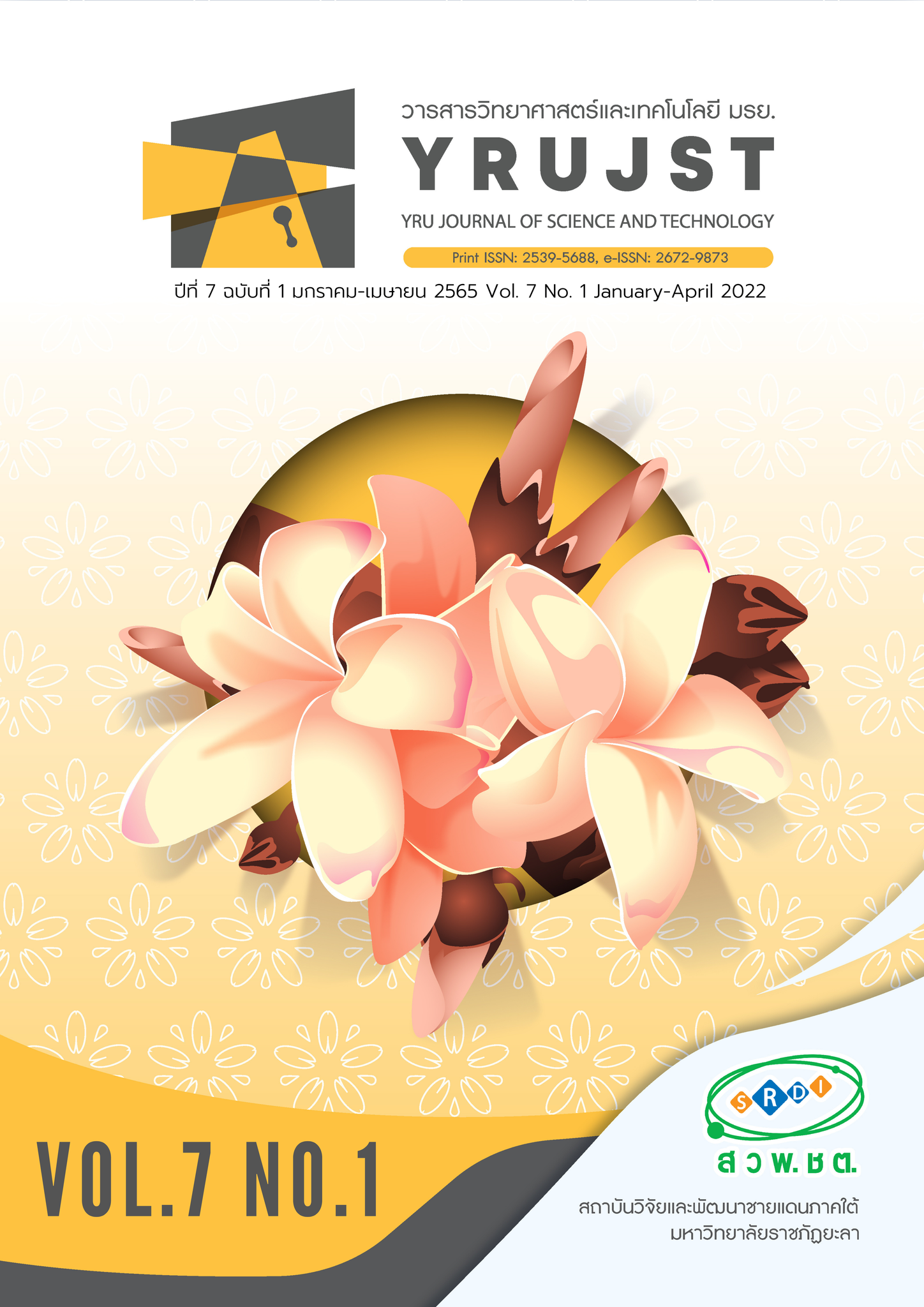Kinetic Adsorption Isotherms of Rhodamine B onto Bagasse Modified Activated Carbon
Main Article Content
Abstract
In this research, study kinetic adsorption isotherm of Rhodamine B onto activated carbons prepared from bagasse which was a natural biomass material left in the community. Therefore, the bagasse was characterized and activated at optimize conditions and used to adsorb Rhodamine B solution to increase the value of agricultural waste. The research studied Rhodamine B adsorption on unmodified bagasse activated carbon (BAC) and modified bagasse activated carbon (BAC-KOH). From the effect of contact time, the kinetic adsorption isotherms of Rhodamine B related to the pseudo-second order for BAC and BAC-KOH. The Langmuir adsorption isotherm fit well, and the calculated maximum adsorption capacities (qm) at 30°C and pH 4.0 were 384.62 and 555.56 mg g-1 for BAC and BAC-KOH, respectively.
Article Details
บทความ ข้อมูล เนื้อหา รูปภาพ ฯลฯ ที่ได้รับการเผยแพร่ในวารสารวิทยาศาสตร์และเทคโนโลยี มรย. นี้ ถือเป็นลิขสิทธิ์ของวารสารวิทยาศาสตร์และเทคโนโลยี มรย. หากบุคคลหรือหน่วยงานใดต้องการนำทั้งหมดหรือส่วนหนึ่งส่วนใดไปเผยแพร่ต่อหรือกระทำการใดๆ จะต้องได้รับอนุญาตเป็นลายลักษณ์อักษรจากวารสารวิทยาศาสตร์และเทคโนโลยี มรย. ก่อนเท่านั้น
References
Barrett, E.P., Joyner, L.G. & Halenda, P.P. (1951). Pore Size Distribution for Porous Materials. Journal of the American Chemical Society, 73, 373–380.
Belhachemi, M. & Addoun, F. (2012). Adsorption of Congo Red onto Activated Carbons Having Different
Surface Properties: Studies of Kinetics and Adsorption Equilibrium. Desalination and Water Treatment, 37, 122–129.
Brunauer, S., Skalny, J. & Bodor, E.E. (1969). Adsorption on Nonporous Solids. Journal of Colloid and Interface Science, 30, 546–552.
Calderóna, J.P., Santos, M.V. & Zaritzky, N. (2018). Reactive RED 195 Dye Removal Using Chitosan Coacervated Particles as Bio-sorbent: Analysis of Kinetics, Equilibrium and Adsorption Mechanisms. Journal of Environmental Chemical Engineering, 6(5), 6749-6760.
Fadzil, F., Ibrahim, S., Megat, A.K. & Megat, H. (2016). Adsorption of Lead (II) onto Organic Acid Modified
Rubber Leaf Powder: Batch and Column Studies. Process Safety and Environmental Protection,
, 1-8.
Freundlich, H. (1907). Ueber Kolloidfällung and Adsorption. Zeitschrift für Chemie and Industrie der Kolloide, 1, 321–331.
Hamdi, M.H. and El-sayed, A.A. (2010). Activated Carbon from Agricultural By-Products for the Removal of Rhodamine-B from Aqueous Solution. Journal of Hazardous Materials, 168(2–3), 1070-1081.
Hayeeye, F. & Sattar, M. (2020). Removal of Crystal Violet in Aqueous Solution by Activated Carbon from the Pericarp of Rubber Fruit and Bagasse: Kinetics, Thermodynamics and Adsorption Studies. Desalination and Water Treatment, 202, 420–434.
Hayeeye, F., Sattar, M., Chinpa, W. & Sirichote, O. (2017). Kinetics and Thermodynamics of Rhodamine B Adsorption by Gelatin/Activated Carbon Composite Beads. Colloids and Surfaces A: Physicochemical and Engineering Aspects, 513, 259–266.
Hayeeye, F., Sattar, M., Tekasakul, S. & Sirichote, O. (2014), Adsorption of Rhodamine B on Activated Carbon Obtained from Pericarp of Rubber Fruit in Comparison with the Commercial Activated Carbon. Songklanakarin Journal of Science and Technology, 36 (2), 177-187.
Ho, Y.S. & McKay, G. (1999). Pseudo-Second-Order Model for Sorption Processes. Process Biochemistry,
, 451–465.
Jia Y.F., Xiao, B. & Thomas, K.M. (2002). Adsorption of Metal Ions on Nitrogen Surface Functional Groups in Activated Carbons. Langmuir, 18, 470–478.
Kuila, U. & Prasad, M. (2013). Specific Surface Area and Pore-Size Distribution in Clays and Shales. Geophysical Prospecting, 62(2), 341-362.
Lagergren, S. (1898). Zur Theorie Der Sogenannten Adsorption Geloster Stoffe, Kungliga Svenska Vetenskapsakademiens. Handlingar, 24, 1–39.
Langmuir, I. (1916). The Constitution and Fundamental Properties of Solids and Liquids Part I. Solids.
Journal of the American Chemical Society, 38, 2221–2295.
Mohammad, F., Rajesh, G.P., Khorshidi. B., Hayatbakhsh, A. & Sadrzadeh, M. (2019). Efficient Treatment of
Oil Sands Produced Water: Process Integration Using Ion Exchange Regeneration Wastewater as A
Chemical Coagulant. Separation and Purification Technology, 221, 166-174.
Santhi, T., Prasad, A.L., Manonmani, S. (2014). A Comparative Study of Microwave and Chemically Treated
Acacia Nilotica Leaf an Eco-friendly Adsorbent for the Removal of Rhodamine B Dye from Aqueous Solution, Arabian Journal of Chemistry, 7, 494–503.
Sattar, M., Hayeeye, F., Chinpa, W. & Sirichote, O. (2017). Preparation and Characterization of Poly (lactic
acid)/ Activated carbon Composite Bead via Phase Inversion Method and Its Use as Adsorbent for Rhodamine B in Aqueous Solution. Journal of Environmental Chemical Engineering, 5, 3780–3791.
Sattar, M., Hayeeye, F., Chinpa, W. & Sirichote, O. (2019). Poly (lactic acid)/Activated Carbon Composite
Beads by Phase Inversion Method for Kinetic and Adsorption Studies of Pb2+ Ions in Aqueous
Solution. Desalination and Water Treatment, 146, 227–235.
Stefanos, G., Barbara, A., Christos, C. & Cesar, P. (2018). Wastewater and Urine Treatment by UVC-Based
Advanced Oxidation Processes: Implications from the Interactions of Bacteria, Viruses and Chemical Contaminants. Chemical Engineering Journal, 343, 270-282.
Tharcila, C.R., Juliana, C.I., Carina, P.M. & Denise, A.F. (2013). Adsorption of Crystal Violet Dye from Aqueous Solution onto Zeolites from Coal Fly and Bottom Ashes. Orbital: The Electronic Journal of Chemistry, 5, 179–191.
Wei, X., Zaharaddeen, N.G., Shichang, S., Ibrahim, L. Wang, L., Lin. M. and Yuan, Z. (2020). Preparation and evaluation of an effective activated carbon from white sugar for the adsorption of rhodamine B dye. Journal of Cleaner Production, 253, 119989.
Yarlagadda, V. N. & Manjunath, S. (2019). Aerobic Granular Sludge Process: A Fast Growing Biological Treatment for Sustainable Wastewater Treatment. Current Opinion in Environmental Science & Health, 12, 57-65.


